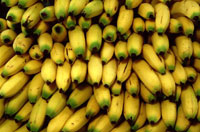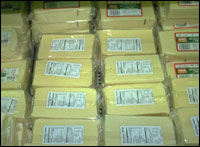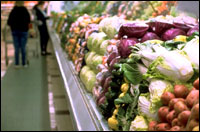I have a young friend who, I think, will never eat another banana without thinking a great deal about its history.

Going bananas.
On a trip to Belize, Hannah and other home-schooled teenagers saw monkeys, the rainforest, and Mayan villages. But the memory that seems to stand out most vividly is of a banana plantation. The workers at the plantation Hannah visited do not wear protective clothing. When planes fly overhead to spray pesticide, the workers take shelter under the nearest banana leaf.
“They say the chemicals make their chests hurt,” Hannah told me.
Hannah reported that mothers bathe their babies in the tubs in which the bananas are washed, sponging off the babies with the residue of whatever chemicals make their fathers’ chests hurt.
At the store where I shop, organic bananas cost 79 cents per pound. Non-organic bananas cost 40 cents per pound. Otherwise, the fruits look identical: bright yellow, cheerful, innocent.
But somewhere between Central America and the U.S. almost the whole story of these bananas has been stripped away. Did the person who picked them earn a fair wage? What chemicals were used? How were they used? All that complexity is reduced to a sticker that says “organic” or “conventional” — and a price tag.
If Hannah stood in the produce section and told her story, how many people in my town would bring home their first bunch of organic bananas?
None of us can act on information we do not have. The organic label doesn’t guarantee that the pickers were paid enough to feed their children. The conventional label doesn’t mean that pesticides were used irresponsibly. And 39 cents extra per pound doesn’t mean anything except 39 cents extra per pound
Once I imagine Hannah standing witness in the banana aisle, my imagination takes off. I begin to populate the whole store with providers of missing information.
Who Moved My Cheese?
Beside the cheese case, I place my friends Marsha and Gail, partners in a small cheese-making business. They could explain what you couldn’t taste in their cheese: how local farmers are now benefiting from the fair price the cheese-makers pay for milk; how the high pasture where the cows graze turns a brilliant shade of green in early spring; how the milk for this cheese never traveled in a gas-guzzling tractor-trailer truck because the cheese room is next door to the milking parlor.

The cheese stands alone.
Their cheese is more expensive than others, but if you could see the farmers, the pasture, and the cleaner air as a part of their product, you’d begin to understand that they are offering a bargain.
This missing information is vital, because a system that makes decisions based on a single variable can only fulfill a single goal. You wouldn’t expect a healthy garden if you only optimized the phosphorous content of your soil. You wouldn’t expect a healthy family if you made all choices based on the needs of only one of your two children.
And yet the reigning assumption in our world is that an economy that takes only price into account can still somehow deliver other goals. Under this assumption, if children are in poverty we must have a “child-poverty crisis.” If ecosystems are struggling we must have an “environmental crisis.” But these are not distinct problems. They are symptoms of a single deep crisis — the crisis of an economy operating with insufficient information and a fundamental inability to pursue any goal beyond that of price.
Whether we are trying to help an estuary or an impoverished nation, we find ourselves struggling against the full force of an economic system that is designed to optimize the bottom line no matter what the consequences for people and nature. This isn’t evil or malevolence. It is just a powerful, informationally bereft system in single-minded pursuit of its only goal.
Instead of exhausting ourselves pushing against such a system, perhaps it is time to redesign it.

Every veggie has a story.
Already we have ideas and technologies that we could borrow creatively. If Fed-Ex can track the exact location of any package anywhere in the world, why can’t we know the history of a bunch of bananas? We can handle countless reviews of books and movies without clogging up the entertainment industry, so why can’t we have reviews of the social and environmental impacts of wedges of cheese, bottles of wine, and bouquets of flowers? Why can’t we estimate the true costs of products and make sure that cost shows up in the final price? Why can’t we find ways to reward the efforts of careful stewards and responsible manufacturers?
People will call me naive for suggesting such ideas. People will say that it is impossible to consciously design a more intelligent economy.
In response I simply say that we won’t know it is impossible until we try. And I ask you to count up all the people who have ever wanted to do the right thing and found it impossible. Impossible because the right thing for land or people doesn’t have a sufficient return on investment to satisfy shareholders, because a responsibly produced product cannot be sold for a low enough price to be competitive, or because a consumer can’t tell which product was made with the future in mind.
Like water held back by a dam, the frustration felt by these people trying to do the right thing represents power; once we see how the battles we are fighting are the product of the obsolete assumptions of our economic system, we will be able to access that power. That is when we will see the veterans of battles to save the whales working alongside the defenders of children, the developers of solar cells, the organizers of migrant laborers, and the business leader of the highest ideals
The world has never known a coalition like that, but it is high time to find out what it could accomplish.

